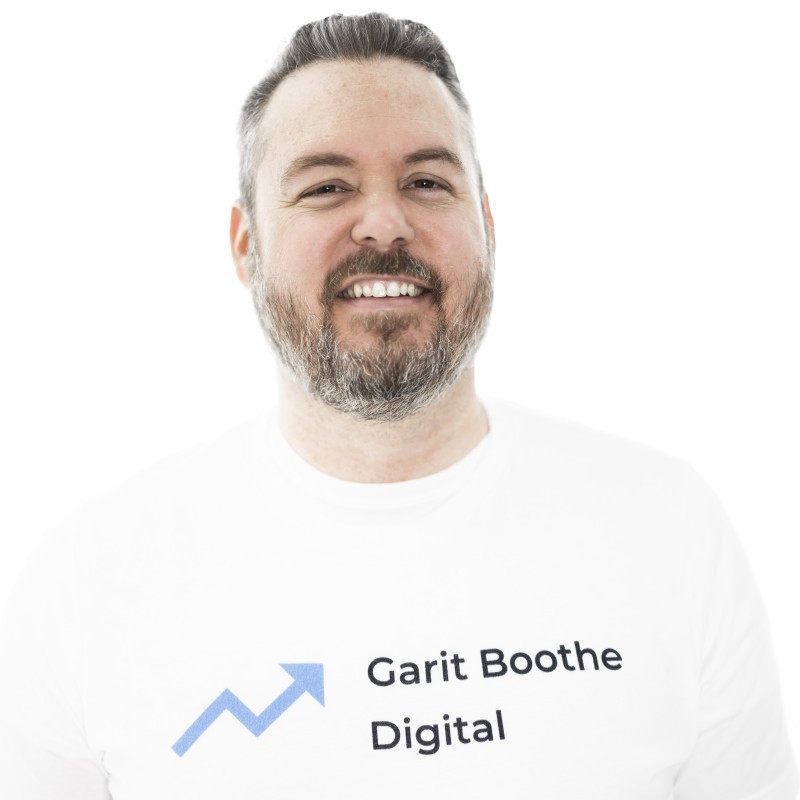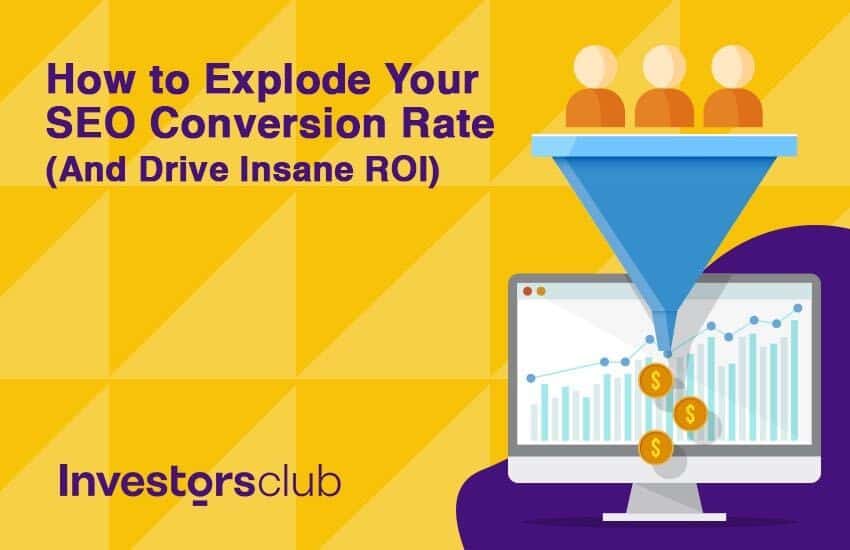When you’re buying a website, monetizing already-existing traffic is one of the best ways to quickly increase your ROI.
How do you know your next acquisition is a real opportunity? This article should give you a few good rules of thumb.
What is a good SEO conversion rate?
4% is a good SEO conversion rate.
Having both worked on and owned my own eCommerce websites, I can confidently say that if you’re getting 4% or more of your website visitors to convert (ie buy from you), you are doing something right.
Anything below 2% is terrible. Most eCommerce sites fall between a 2-4% conversion rate.
For a reference point, our paid search brethren at WordStream found that the average Google search ad conversion rate is 4.4%, but that varies across industries.

For SaaS and content businesses, calculating the conversion rate gets way more complicated. There tends to be lots of micro conversions along the way to a purchase, like clicking on an affiliate link or signing up for a lead form.
That being said, I recently worked on SaaS solution pages that had 25% sign-up rates for freemium products. I’ve also worked on content websites where 30%+ of the organic traffic on the page clicked on the affiliate links.
And I’ve worked on plenty of websites with less than 0.5% conversion rate.
Here are a few things that I learned along the way.
How to increase your SEO conversion rate
1. Target buyer keywords
The great thing about search traffic is that you know what your users are looking for.
“Best”, “versus” and “review” are all keywords that indicate buyer intent. For example, someone actively searching on Google for “best security software” already knows that they want security software. They are shopping for which brand and product to choose from.

People searching for product names have buyer intent. Model numbers and branded product names fall under this category.
Anytime people are searching with the modifiers “price”, “buy” and “cost”, you know they are primed for the purchase.
So if you want to increase your conversions, the first step is simple: target more keywords with buyer intent.
2. Optimize your offer to your keyword
The next step flows naturally from the first. If you know what keyword someone is actively searching for when they land on your website, you can tailor the experience exactly to that.
Say someone is searching “best mobile credit card reader”. A page that I used to work on in this very niche looked just like this:

The above-the-fold experience gives users the information that they are looking for: which brand is the “best” and why. It also has product pictures and brand names with top features, all laid out side-by-side.
A couple of page scrolls down, the user finds this table:

This comparison table gives pricing information and other valuable buyer details in an easy-to-read format. And of course, the call-to-action buttons are prominently displayed.
On average, about 25% of page users would click on either the package cards listed above, or the table listed below. An additional 5% of users would click on CTAs placed elsewhere on the page.
Altogether, about 30-35% of page users would click on the CTAs consistently – which of course were affiliate links.
This was a top-earning page on that website the entire time that I worked on it.
It’s important to note a couple of things about this.
First, I don’t think it would win any design awards. Aesthetics aren’t the point.
Second, “best mobile credit card readers” isn’t a high search volume keyword. Buyer keywords often don’t have a high search volume.
Yet when you match the right search intent to the right offer, you’ll see sky-high conversion rates every time.
If you’re getting a 20% conversion rate and a $50 average order value, you don’t need 100,000 users a month to your page. 100 users per month will do. Those 100 users will turn into 20 buyers, and now you have a $1,000 per month webpage.
How many pages like that do you need to build a profitable web property?
3. Make your CTA easy
I see so many websites making the conversion experience difficult. It causes me deep pain.
When doing conversion rate optimization, one of my main principles is to reduce friction.
If you have a consumer-facing website, chances are that the majority of your traffic is on mobile. From what I typically see, consumer organic search traffic can be anywhere from 55-70% mobile.
I’ve seen many such sites require consumers to complete a 6-field lead form.
Do you know how hard it is to type letters in form fields on your phone?!
And they wonder why they have a 0.2% conversion rate.
A better alternative on mobile would be to:
- Offer a click-to-call button
- Ask to sign up for a text list
- A one-form, email-only opt-in
- A one-click purchase, like how Amazon does it
4. Create a sales funnel
In addition to optimizing your CTAs, consider optimizing your marketing offers.
If someone finds your website for the first time through search, through a non-buyer keyword, they’re usually not ready to purchase.
You’re on a first date.
So don’t propose marriage.
Marriage equals asking for the full sale.
Instead, dangle a lead magnet in front of them. Then you can remarket to them later.
Offer them something so enticing, so awesome, that they feel compelled to act, right then and there.
Typical lead magnets look like coupons, cheat sheets, guides, or mini-video series.
They can work ok, and sometimes really well, if they’re carefully crafted.
But if you want to really dominate?
Offer something that they would normally pay for for free.
This could be a t-shirt, a physical book, or a song/audio file. Before the internet got big, legendary marketer Jay Abraham convinced one of his clients to give away silver coins in exchange for newsletter sign-ups.
Look at all of the free stuff that Jay’s website is currently giving away. How many best-selling books are you giving away?

One reason I think that software companies can grow so explosively is that the industry has mastered the freemium model.
Spotify, YouTube, Google, Facebook – all FREE. They give away incredible value at no cost to the end user.
And they create incredibly addicting, useful products.
Now of course most businesses can’t offer a freemium model. But the principle is universal: offer value first. Gain an audience. THEN sell.
Make your initial conversion metric be:
- Email opt-ins
- Text message list opt-ins
- Freemium product sign-ups
- Social media followers
- Sign up for the free app
You get it – provide them with value and trust. Get them into your sales funnel, but don’t try to get the sale on the first time, most of the time.
Think about it: even on webpages where you’re “crushing it” with a 20% conversion rate, that still means that 80% of your website visitors aren’t buying from you.
Which is perfectly ok: they’re not ready yet. They need time to think, shop, and compare. They’re still getting to know you.
To build a scalable business, you need to answer these questions:
- How many touch points does it take for a website visitor to buy?
- How long does that process take?
- And how much does it cost you?
5. Use Google Analytics to find problems
In the due diligence process, you should be getting access to a website’s Google Analytics dashboard.
This can be a goldmine of information, if you know what to look for.
An under-optimized website has:
- Low conversion rates
- Only one marketing channel
- Low session duration
- High bounce rate
- High page load speeds
When I analyze a website, I’m looking for problems. Data that indicates that something is off.

Is the conversion rate lower on mobile? Are certain landing pages not converting? Is all of the traffic only going to three pages?
Each of these problems usually has a cause, and a solution.
If a website is relying only on paid ads, then you can diversify with SEO and organic social media.
If a website is relying solely on SEO, then you can instantly add an email capture and remarketing ads to ramp things up.
If a website has high domain authority, but little organic search traffic, you can rank quickly with new content.
And so on.
A great hack that you can use after a recent acquisition is to install better analytics. Google Analytics is a great free tool, which most of us are very comfortable in. But it has limitations.
I like Woopra because it’s also free, but has more advanced functionality than Google Analytics.
Most small eCommerce and SaaS companies are flying blind when comparing the logged in and logged out experience of their websites. How many of your “anonymous users” in Google Analytics are your actual customers?
Woopra solves this problem.
Once someone creates an account, Woopra tracks that user across all of your experiences: the public-facing website, logged into their account/product, and even in a mobile app.
Once you can see what your customers are doing on both an individual and aggregate level, you can now make much better marketing decisions.
Again – you need to know how many touch points a user requires to buy from you. If you ramp up the touch points, you ramp up the sales.
6. Don’t forget mobile
As I’ve mentioned before, an unoptimized mobile experience is a common error.
Despite “mobile first” being the mantra for the past decade, I don’t think that most web experiences really reflect this.
First, I want to add the caveat that many B2B websites don’t need a mobile-first experience. If two-thirds of your traffic is on desktop, mobile can be an afterthought.
But most websites get most of their traffic from people on their phones.
Again, your analytics should give you an idea of what is happening on mobile.
Is the conversion rate lower than on desktop? Is the bounce rate higher? Is the time on-page lower?

After looking at the numbers, do a visual inspection of high-traffic pages. Often, you’ll see things like CTAs that have been shoved to the bottom of the page. This comes from a clumsy responsive design.
You may find that the images are way too big, or that the headlines look funny.
And as I mentioned before, make sure to optimize your CTA for someone who is on their phone.
Google has a mobile friendly test that you can plug any URL into. Google Search Console also gives a list of pages that aren’t optimized for mobile.
If you’re a website investor, an unoptimized mobile website is a massive opportunity. If all that you have to do is put a website on a new Shopify or WordPress theme to fix the technical mobile issues, then that should result in an instant boost in conversions.
Another common problem with most mobile experiences is that page load speeds are significantly slower.
7. Increase page speed
At times I feel like slow page speed is the bane of my existence. But the good news is that once you solve it, it helps your website in a ton of ways.

Many studies have shown that speeding up your website increases purchases. Straight up.
Google has a nifty calculator to help you see how much money increased page speed could make your website. In a joint Google/Deloitte study, they found that improving your load time by 0.1 seconds can boost conversion rates by 8%.
So if you do the math, improving load times by 1 whole second can improve conversions by 80%.
Not bad, right?
Your goal should be to get your total page load speed down to 2 seconds or less.
But there are various micro pagespeed metrics to look at. Time to first byte (TTFB) and Visual Complete are micro-metrics that tell you how fast a server can reach your page and become visually operational for users.
In a comprehensive study by Brian Dean at Backlinko, he found that, “the average Time to First Byte speed is 1.286 seconds on desktop and 2.594 seconds on mobile. The average time it takes to fully load a webpage is 10.3 seconds on desktop and 27.3 seconds on mobile.”
Furthermore, he found that, “The average web page takes 87.84% longer to load on mobile vs. desktop.”
Google is desperately trying to incentivize webmasters to improve page speed. This is why they announced earlier this year that they are including “Core Web Vitals” as an additional ranking signal in their algorithm.

These are largely pagespeed and functionality metrics. In other words, the more you improve your page speed, the more it should help SEO.
Currently, page speed load times aren’t a huge part of Google’s ranking algorithm. But they increasingly will become more important over the next few years.
The question is, how can you improve your page load speeds?
There are a few quick and universal answers:
- Get a faster web host
- Get a fast CDN
- Decrease image size
- Implement page caching
There are services and plugins that can help you with all of these.
If you’re serious about improving pagespeed, I would highly recommend working with a front-end developer who is a pagespeed expert. Most developers don’t really know how to create fast websites. I’ve worked with many, and usually the average developer doesn’t make much headway with this.
There are out-of-the-box services for pagespeed, too.
- Ezoic has a page speed product that guarantees a Google page speed test score of at least 80/100 on both mobile and desktop
- There are various AMP plugins on WordPress, including the official WordPress AMP plugin
- WPX hosting is blazing fast. I use them for my website. It was built from the ground up for speed and SEO, and their customer service is great.
If you’re working on a small website on a budget, then the best easy things that you can do for site speed are to get fast hosting, get a fast theme, compress your images, and roll out AMP on your blog.
All of this is easy to do without a developer.
Putting together the pieces
Websites and businesses are like jigsaw puzzles.
There are so many little pieces that need to fit together. I hope that these conversion tips help take your current projects to the next level.

Search Engine Optimization Consultant
Garit is an SEO consultant and website owner. He has extensive experience with SaaS and content businesses.
Connect with Garit:
Linkedin | Garit Boothe Digital

